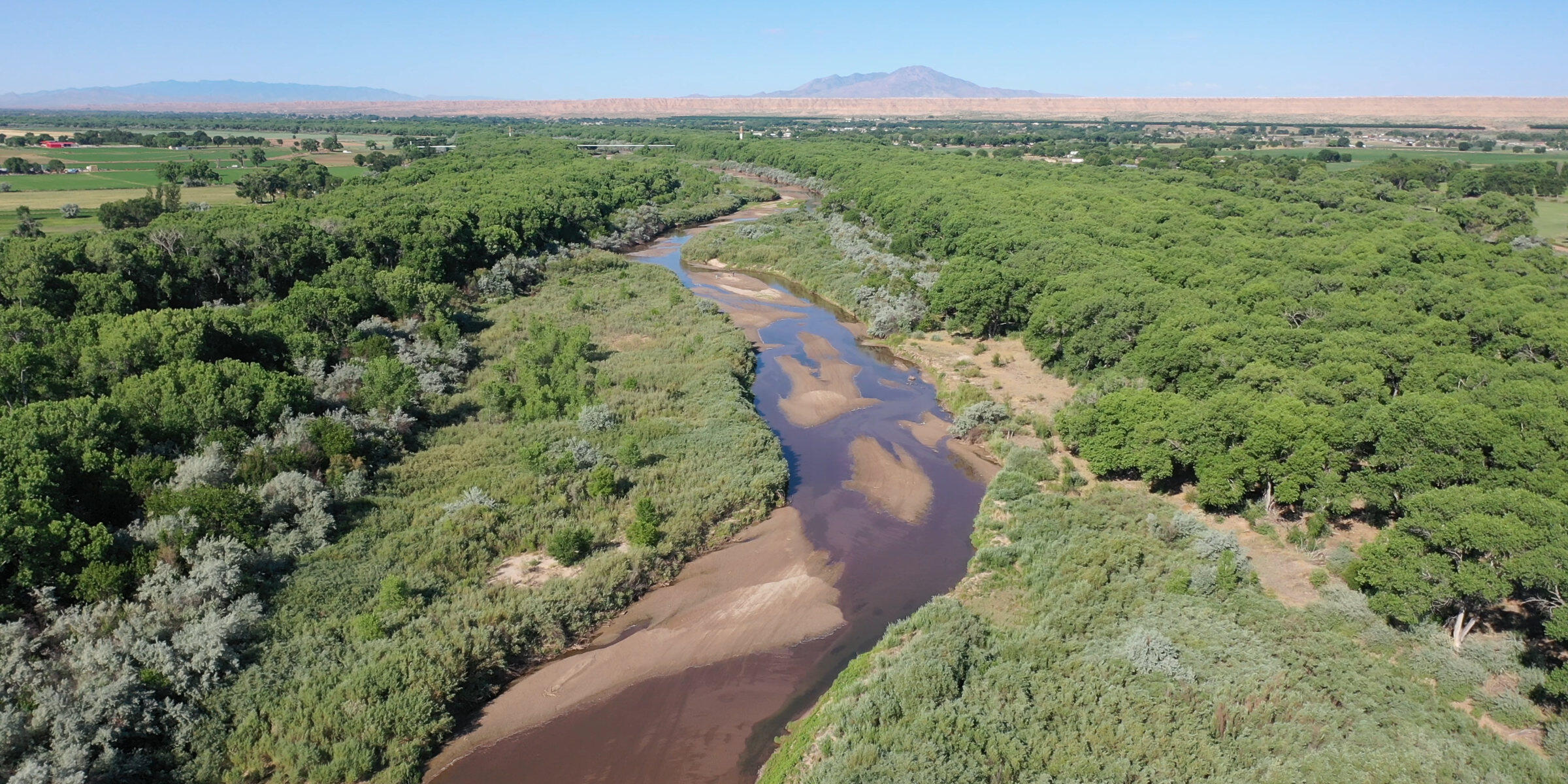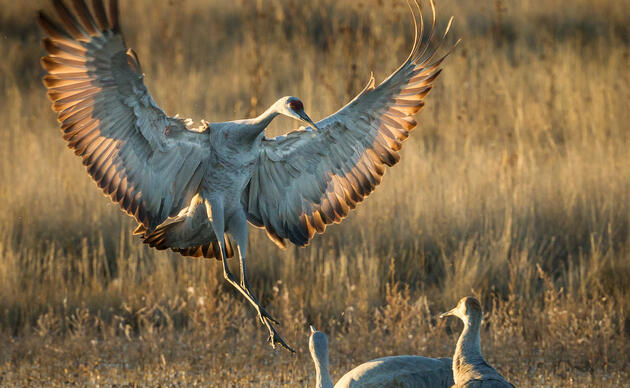The Ribbon of Life Initiative
Conserving the Natural and Cultural Heritage of the Rio Grande in New Mexico
The Rio Grande, a Ribbon of Life
The Rio Grande is among the most iconic rivers in the western United States. As the second longest river in the continental U.S., and the fifth longest river in North America. The Rio Grande flows approximately 1900 miles from the San Juan Mountains in Southern Colorado to the Gulf of Mexico in Texas. For over 1200 miles, the Rio Grande is the border between Texas and Mexico. The Rio Grande ecosystem supplies irrigation for food production in both America and Mexico as well as renewable drinking water to fast growing urban centers on both sides of the international border. At the same time, the Rio supports large-scale ecological processes like continental migration of hundreds of thousands of birds, bats and butterflies, including vital habitat for seven of the eight Audubon priority bird species for riparian areas in the west – Yellow Warbler, Yellow-breasted Chat, Summer Tanager, Bell’s Vireo, Sandhill Crane, Southwestern Willow Flycatcher and Western Yellow-billed Cuckoo.
The Rio Grande flows more than 450 miles in New Mexico from the Colorado-New Mexico state line to El Paso, Texas. The area classified as the Middle Rio Grande runs 175 miles from Cochiti Reservoir to Elephant Butte Reservoir. This region includes 6 Sovereign Native Nations, the greater metropolitan areas of Albuquerque and Santa Fe, extensive rural farmland and prominent wildlife management areas including Bosque del Apache National Wildlife Refuge and La Joya State Game Refuge. Along with supplying drinking water to growing urban centers and supporting extensive agricultural production, this section of the river serves as the backbone of a highly profitable tourism and outdoor recreation industry that can provide long-term sustainable economic growth for the region.
The Time to Save the Rio Grande Is Now
The Rio Grande is under duress due to over allocated water, crumbling infrastructure, and outdated water management laws and guidelines. These threats to the river, people and wildlife are compounded by the adverse consequences of climate change. Climate changes will continue to impact water supply, reservoir evaporation, influence flood control considerations, habitats, water quality, natural groundwater recharge and agricultural water demand.
Despite the demands on the Rio Grande and the grizzly future water supply scenarios, there are ample opportunities for proactive and meaningful conservation activities that will ensure a healthy future for the many bird and human communities that rely on this ribbon of life. In the Middle Rio Grande of New Mexico, the native ecosystem and dependent farm communities have shown much resilience to past droughts. Any activities that improve water supply and habitat within this area only strengthen this resilience and provide longevity for, as an example, the Rio Grande Native American Pueblos, the City of Albuquerque and the Bosque del Apache National Wildlife Refuge. Every strategic conservation effort within this area provides additional long-term resilience. The time is ripe for innovative solutions to water shortages within the Rio Grande that benefit both people and birds. Audubon has demonstrated its ability to lead conservation efforts and transform water policy in the basin, and is playing a key role in finding much needed future solutions.
Audubon’s Strategy for Conservation on the Rio Grande
Audubon Southwest has been working to solve Rio Grande conservation issues for over 20 years with early efforts addressing the protection and conservation of the Rio Grande Silvery Minnow, precedent-setting environmental water rights transactions, engagement with the Middle Rio Grande Endangered Species Act Collaborative Program, and assistance with numerous restoration projects throughout the corridor. Today, Audubon is active within the Middle Rio Grande of New Mexico on many fronts, most notably environmental water transactions, and policy transformation, habitat restoration, engagement with agency conservation efforts and education.
Water Transactions: Audubon has established innovative water markets that allow water right holders to restore a portion of nature’s share of water in the Middle Rio Grande and at key riparian and wetland habitat sites through voluntary, market-based environmental water transactions. In June of 2014, Audubon and partners celebrated a first-ever irrigation for native plant and habitat restoration with acquired water rights along the Lower Rio Grande. In 2016 Audubon celebrated another historic milestone; by entering into the first-ever partnerships with 4 MRG Pueblos (Pueblos of Sandia, Isleta, Santa Ana, Cochiti) and the Club at Las Campanas to release 799 acre feet of water into the Middle Rio Grande for the purpose of restoring environmental flows. Audubon continues this work by contracting with 3 municipalities to deliver water to strategic locations along the Middle Rio Grande. Additionally, Audubon provides technical support to the Middle Rio Grande Conservancy District
Transforming Water Policy & Management: Audubon has led the way in transforming New Mexico water policy through the on-the-ground environmental water transactions described above and policy initiatives with New Mexican federal legislatures. Audubon was the first non-profit organization to obtain San Juan Chama water, have it stored in the state’s environmental pool, and direct its flow. Audubon received a precedent-setting permit from the New Mexico Office of the State Engineer for the transfer of a private water right to in-stream use. By engaging in these precedent setting water transactions, Audubon is leading the way in modernizing New Mexico’s water policy and management. Audubon also works to reform state and federal appropriations, laws and regulations to increase public funding for water conservation and habitat restoration, to expand the beneficial use of water to birds and wildlife, and to modernize outdated basin wide reservoirs and water infrastructure to maximize flexibility, efficiency, and optimization of water supply, storage, and delivery for use by people and nature.
Habitat Restoration: Audubon has assisted with identifying and coordinating habitat restoration activities for critical wildlife and bird species, including the Southwest Willow Flycatcher and the Yellow-billed Cuckoo, two species of conservation concern. Audubon provides technical assistance for the Middle Rio Grande Conservancy District’s Conservation Program, This Program includes the restoration of irrigation returns, or “outfalls”, to the river in the Isleta Reach (just below Albuquerque). These outfalls have been the delivery location of our leased water and are critical locations for providing habitat resiliency during drought.
Agency Engagement: Audubon is engaged with water management agencies in Middle Rio Grande conservation efforts including the Middle Rio Grande Conservancy District, the Middle Rio Grande Endangered Species Act Collaborative Program (State and Federal agencies), the New Mexico Water Policy and Infrastructure Task Force, and the Upper Rio Grande Basin Study (Middle Rio Grande Conservancy District and US Bureau of Reclamation). We are also engaged with State water management agencies through our water transaction work.
Education and Awareness: Audubon New Mexico is a recognized leader in environmental education and conservation field experiences throughout the state. Working with partners like US Fish and Wildlife Service (USFWS) at the Valle do Oro National Wildlife Refuge, the Valencia Soil & Water Conservation District, and the public school systems, Audubon provides high quality nature-based educational experiences to children and adults about the importance of a healthy Rio Grande River through our Birds of a Feather Explore Together and Taking Flight curriculums. Additionally, Audubon engages corporate leaders and institutions in educational and service programs that benefit the river and its riparian habitats. Audubon also manages the Isleta Reach Stewardship Association, an agency and community group that is focused on the Isleta Reach of the Middle Rio Grande.
How you can help, right now
Join the Western Water Action Network
Receive action alerts about water issues, and issues that are affecting birds across the arid West.
Donate
Help secure the future for birds at risk from climate change, habitat loss, and other threats. Your support will power our science, education, advocacy and on-the-ground conservation efforts.
Nina Mason Pulliam Rio Salado Audubon Center
Visit the Nina Mason Pulliam Rio Salado Audubon Center in Phoenix, Arizona.




